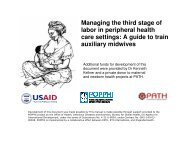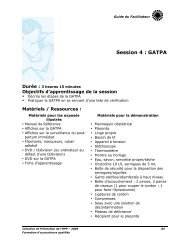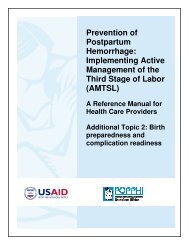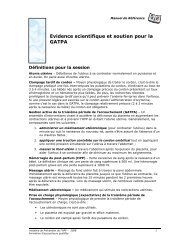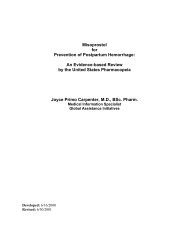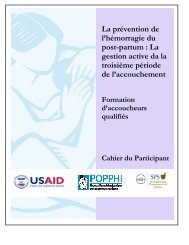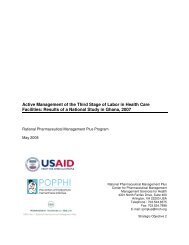El Salvador - Active Management of the Third Stage of Labor - POPPHI
El Salvador - Active Management of the Third Stage of Labor - POPPHI
El Salvador - Active Management of the Third Stage of Labor - POPPHI
You also want an ePaper? Increase the reach of your titles
YUMPU automatically turns print PDFs into web optimized ePapers that Google loves.
2. MethodsThis study is part <strong>of</strong> a multiple country study to assess use <strong>of</strong> AMTSL among facility-baseddeliveries. The development <strong>of</strong> <strong>the</strong> study was a participatory process which involved an initialexpert meeting in Washington, DC in May 2005 to elicit feedback on <strong>the</strong> draft protocol, aplanning workshop in Nairobi, Kenya in July 2005 for <strong>the</strong> first two country studies, and planningworkshops in Panama and <strong>El</strong> <strong>Salvador</strong> in January and February 2006 with representatives <strong>of</strong> <strong>the</strong>Central American Federation <strong>of</strong> <strong>the</strong> Associations and Societies <strong>of</strong> Gynecologists andObstetricians (COMIN-FECASOG) to fur<strong>the</strong>r refine <strong>the</strong> protocol and questionnaires before <strong>the</strong>beginning <strong>of</strong> data collection in <strong>El</strong> <strong>Salvador</strong>, Guatemala, Honduras, and Nicaragua.In <strong>the</strong> case <strong>of</strong> <strong>El</strong> <strong>Salvador</strong>, prior to data collection <strong>the</strong> study protocol was submitted to andapproved by <strong>the</strong> Ministry <strong>of</strong> Public Health and Social Work (MSPAS) <strong>of</strong> <strong>El</strong> <strong>Salvador</strong>. Followingthis approval, <strong>the</strong> protocol was submitted to <strong>the</strong> Committee for Human Research at <strong>the</strong> JohnsHopkins Bloomberg School <strong>of</strong> Public Health in Baltimore, Maryland. The Johns HopkinsCommittee for Human Research judged <strong>the</strong> protocol to be exempt from review for humansubjects research because no personal identifiers were collected and because <strong>the</strong> proceduresobserved were all standards <strong>of</strong> care. They did specify that informed consent must be obtained atadmission to <strong>the</strong> health facility and not in <strong>the</strong> labor and delivery room. In this study, informedconsent consisted <strong>of</strong> describing <strong>the</strong> study and requesting participation from women at admissionto <strong>the</strong> health facility. PATH deferred to Johns Hopkins for <strong>the</strong>ir review. The MSPAS did notconsider review by local ethics committees to be necessary.Questionnaire developmentThe processes and outcomes identified in <strong>the</strong> conceptual framework for <strong>the</strong> study (Figure 1.1)determined <strong>the</strong> content and number <strong>of</strong> questionnaires required for <strong>the</strong> study. In all, threequestionnaires were developed:• National-level questionnaire. This questionnaire was designed to capture <strong>the</strong> policyenvironment for AMTSL. It includes questions regarding <strong>the</strong> content <strong>of</strong> <strong>the</strong> essential druglist, STGs, pre-service training curricula, procurement practices for uterotonic drugs, andstorage conditions for uterotonic drugs at <strong>the</strong> central pharmaceutical storage site. Completingthis questionnaire required document review, interviews with MOH staff and o<strong>the</strong>rpolicymakers, and a visit to <strong>the</strong> pharmaceutical storage site. The study’s country coordinatorconducted <strong>the</strong> national-level data collection.• Facility-level questionnaire. This questionnaire was designed to capture <strong>the</strong> policyenvironment at <strong>the</strong> individual facility level. It includes questions on <strong>the</strong> availability <strong>of</strong>clinical guidelines in <strong>the</strong> facility, provision <strong>of</strong> in-service training on AMTSL, <strong>the</strong> cost <strong>of</strong>uterotonic drugs to <strong>the</strong> facility and to patients, access to <strong>the</strong> facility pharmacy, procurementpractices for uterotonic drugs, and supply and storage conditions at <strong>the</strong> facility. Completingthis questionnaire required interviews with hospital administrators and <strong>the</strong> pharmacist and avisit to <strong>the</strong> facility pharmacy. One <strong>of</strong> <strong>the</strong> two members <strong>of</strong> <strong>the</strong> data-collection team completedthis questionnaire during his/her visit to selected facilities.• Observation-<strong>of</strong>-deliveries questionnaire. This questionnaire was designed to documentprovider practices during <strong>the</strong> third stage <strong>of</strong> labor and <strong>the</strong> first 30 minutes <strong>of</strong> <strong>the</strong> fourth stage8



